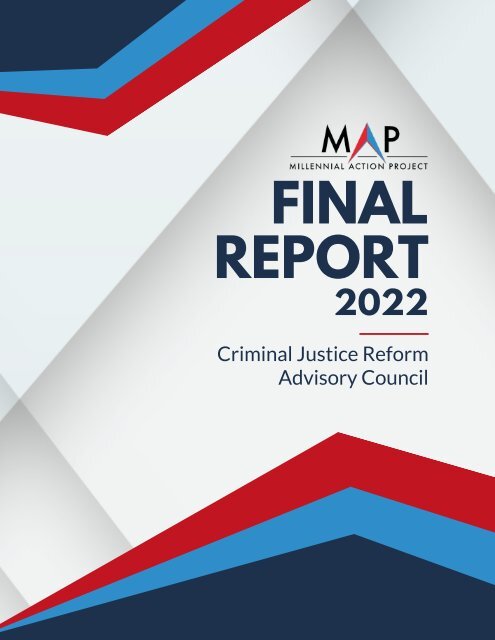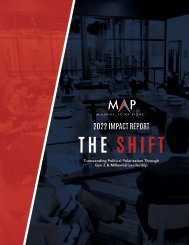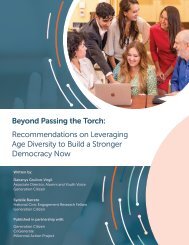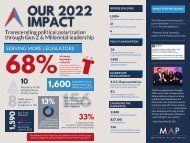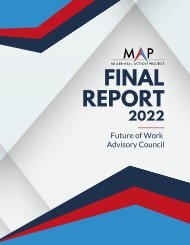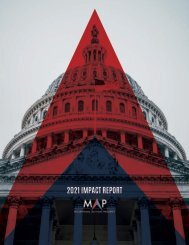Criminal Justice Reform Advisory Council Report 2022
You also want an ePaper? Increase the reach of your titles
YUMPU automatically turns print PDFs into web optimized ePapers that Google loves.
FINAL<br />
REPORT<br />
<strong>2022</strong><br />
<strong>Criminal</strong> <strong>Justice</strong> <strong>Reform</strong><br />
<strong>Advisory</strong> <strong>Council</strong>
Table of Contents<br />
01<br />
Foreword p 03<br />
02<br />
Meet the <strong>Advisory</strong> <strong>Council</strong> Members<br />
p 04<br />
03<br />
Introduction<br />
p 05<br />
04<br />
Sentencing <strong>Reform</strong> for Youth<br />
p 06<br />
05<br />
Bail <strong>Reform</strong> for Youth<br />
p 08<br />
06<br />
Youth Miranda Rights<br />
p 09<br />
07<br />
Anti-Recidivism Efforts for Youth p 10<br />
08<br />
Youth Facilities<br />
p 11<br />
09<br />
Parents in the Prison System<br />
p 12<br />
10<br />
Conclusion<br />
p 13
0 3<br />
Foreword<br />
Foreword<br />
In this time of heightened political polarization, few policy areas have seen bipartisan<br />
cooperation as much as criminal justice reform. In red, blue, and purple states, legislators<br />
have grabbed headlines for their efforts to put aside seemingly intractable rivalries to<br />
develop new insights and coalitions that attempt a more equitable system of justice for all<br />
Americans.<br />
There is an urgency to this work. By several measures, the United States maintains one of<br />
the largest incarcerated populations in any developed country. The ramifications of this<br />
fact are staggering on our economy, political system, and society as a whole. <strong>Reform</strong>ers<br />
cannot afford to be thwarted by partisan bickering.<br />
To help provide a framework for legislators to meet and hold discussions on this<br />
important issue, Millennial Action Project launched the second iteration of the <strong>Criminal</strong><br />
<strong>Justice</strong> <strong>Reform</strong> <strong>Advisory</strong> <strong>Council</strong> for the year of <strong>2022</strong>. Convened with the intention of<br />
building on the work of the <strong>Criminal</strong> <strong>Justice</strong> <strong>Reform</strong> <strong>Advisory</strong> <strong>Council</strong> of 2021, this year’s<br />
efforts prioritized in-depth discussions on specialized criminal justice issues, primarily<br />
juvenile justice.<br />
The past few years have seen legislatures across the country move forward with no<br />
shortage of ideas and proposals to overhaul the treatment of our nation’s children within<br />
the criminal justice system. From sentencing reform to bail reform, from protecting<br />
Miranda rights to anti-recidivism policies, the road to a more just future for juvenile<br />
justice remains wide open and ready to be pioneered by young elected officials who have<br />
already brought so much passion and attention to these important topics.<br />
This report details the issues discussed by the CJRAC and the key areas where young,<br />
bipartisan leaders at the state level are seeking to make their voices heard in the<br />
legislative sessions ahead.
Meet the Members<br />
Meet the <strong>Criminal</strong> <strong>Justice</strong><br />
<strong>Reform</strong> <strong>Advisory</strong> <strong>Council</strong><br />
The second iteration of the <strong>Criminal</strong> <strong>Justice</strong> <strong>Reform</strong> <strong>Advisory</strong> <strong>Council</strong> was finalized in early<br />
<strong>2022</strong>. The first meeting was held on May 26th. All of the members on this panel<br />
demonstrate dynamic bipartisan leadership relating to criminal justice reform policies in<br />
their respective legislatures. In the CJRAC’s meetings, these legislators met with outside<br />
experts and had conversations among themselves regarding the status of juvenile justice<br />
reform, building off of the work done by the previous <strong>Criminal</strong> <strong>Justice</strong> <strong>Reform</strong> <strong>Advisory</strong><br />
<strong>Council</strong> in 2021.<br />
This report details approaches to criminal justice policy identified by members of the<br />
<strong>Criminal</strong> <strong>Justice</strong> <strong>Reform</strong> <strong>Advisory</strong> <strong>Council</strong> relating to juvenile justice reform. State<br />
legislator participation on MAP’s Future of Work <strong>Advisory</strong> <strong>Council</strong> does not imply<br />
individual support for any or all of the methods identified in this document.<br />
<strong>Council</strong> Members<br />
Rep. Daniel Pae (R-OK)<br />
Co-Chair<br />
Rep. Jamie Scott (D-AR)<br />
Co-Chair<br />
Rep. Torren Ecker (R-PA)<br />
Sen. Mujtaba Mohammed (D-NC)<br />
Rep. Sara Rasmussen (R-AK) Rep. Leonela Felix (D-RI) Rep. Bobby Cox (R-SC) Rep. Taylor Small (D-VT)
0 5<br />
Introduction<br />
Introduction<br />
The second iteration of the Millennial Action Project’s <strong>Criminal</strong> <strong>Justice</strong> <strong>Reform</strong> <strong>Advisory</strong><br />
<strong>Council</strong> built on the recommendations of the first. Among the most pressing topics<br />
identified for further attention was juvenile justice reform.<br />
Over the course of its meetings, the CJRAC discussed a variety of issue areas and<br />
proposals relating to juvenile justice reform and met with several different issue area<br />
experts. Legislators had an opportunity to strategize with leading organizations and<br />
practitioners to identify areas with the greatest potential for reform.<br />
This report summarizes the research and findings presented to the council members,<br />
including various pieces of bipartisan legislation that can serve as a model for other states.
Sentencing <strong>Reform</strong><br />
Sentencing <strong>Reform</strong> for Youth<br />
Sentencing reform for young offenders can best be summarized as efforts intended to lower the overall number of<br />
incarcerated youth. While incarceration rates have declined, there is still work to be done in reducing demographic<br />
disparities among currently incarcerated youth and limiting youth in adult facilities.<br />
Positive Trends and Legislative Results<br />
Youth Incarceration Rates Nationwide are Decreasing<br />
The Sentencing Project, one of the nation’s leading advocacy groups on justice reform,<br />
found that the number of teenagers committed to juvenile facilities in the U.S. has<br />
fallen almost two-thirds since its peak of 76,000+ in 2000. The Sentencing Project<br />
credits this development to a web of state policies and initiatives ranging from the<br />
promotion of least-restrictive detention options for juveniles to increasing the age<br />
limit for juvenile court jurisdiction.<br />
Causation Legislation<br />
FLHB 885 (Bipartisan, Enacted, 2021): Requires a court to consider specified<br />
information before ordering a child into custody for failure to appear. The intent of<br />
this legislation is to reduce the amount of juvenile detentions based on the state’s<br />
failure to properly communicate with these individuals.<br />
OK HB2311 (Bipartisan, Enacted, 2021) : Prohibits the detention of all persons under<br />
18 years of age in an adult facility except in certain circumstances. The intent of this<br />
legislation is to reduce exposure of juveniles to adult facilities.<br />
Areas for legislative solutions<br />
Racial Disparities in the Juvenile System<br />
Racial disparities in incarceration rates have been a persistent problem in the criminal<br />
justice system. According to the National Association of <strong>Criminal</strong> Defense Lawyers,<br />
juvenile incarceration has proved no different:<br />
Non-white juvenile incarceration rates have have declined at a slower rate<br />
compared to white juveniles;<br />
The racial disparity between black and white youth in custody increased by 22%<br />
from 2001 to 2015;<br />
Black youth accounted for 67.7% of mandatory and discretionary transfers to the<br />
adult prison system in 2016;<br />
On average, judges give 7.8% longer prison sentences to black youth compared to<br />
white youth for the same offenses.
0 7<br />
Sentencing <strong>Reform</strong><br />
Youth in Adult Facilities<br />
In 2019, 2,900 juveniles nationwide were incarcerated in adult jails and 653 were<br />
incarcerated in adult prisons, according to The Sentencing Project. Every year, an<br />
additional 95,000 juveniles are housed in adult jails or prisons. The Equal <strong>Justice</strong><br />
Initiative (EJI), a legal nonprofit that supports underprivileged prisoners, conducted<br />
research that found placing young offenders in adult facilities increases the likelihood<br />
of being sexual assaulted by five times and increases the likelihood a juvenile attempts<br />
suicide by nine times. EJI also writes that many juveniles in the adult criminal justice<br />
system suffer from untreated mental illness, while lacking adequate safeguards in<br />
adult facilities to properly shield them from violence.<br />
Solution-Focused Legislation<br />
ME LD 2 (Partisan, Enacted, 2021): Provides for a study with the eventual goal of<br />
establishing and implementing a system of using racial impact statements for criminal<br />
justice bills during the legislative process.<br />
MD SB165 (Partisan, Not Enacted, <strong>2022</strong>): Prohibits any automatic charging of a youth<br />
offender as an adult in a court of law. The intent of this legislation is to limit the amount<br />
of youth serving in adult facilities.
Bail <strong>Reform</strong><br />
Bail <strong>Reform</strong> for Youth<br />
Bail reform refers to policies that reduce or eliminate financial burdens placed on young offenders through the court<br />
system. Such efforts can focus on either young offenders established as indigent or young offenders as a whole.<br />
Areas for Legislative Solutions<br />
Unaffordable Cash Bail for Young Offenders<br />
The permissibility of cash bail for young offenders has emerged as a topic of growing<br />
concern among criminal justice advocates. Bail for juveniles is mostly determined by<br />
state law. The National Juvenile Defender Center (NJDC) commissioned a report in<br />
2019 to document each state’s practices regarding juvenile bail. This report found that<br />
bail for children was “a matter of pure judicial discretion” with some defense attorneys<br />
reporting bail numbers ranging into the tens- or hundreds-of-thousands of dollars and<br />
no discussion of ability to pay. Even bail as low as $75 presented difficulties for a<br />
family to post. Unaffordable bail was shown to result in longer detentions of children<br />
before trial, separating them from their families based solely on an inability to pay.<br />
Controversy Regarding Bail <strong>Reform</strong>'s Effectiveness<br />
With national concern over the increase in crime rates, bail reform policies have<br />
attracted attention as a potential contributing factor. Opponents of lessening bail<br />
restrictions argue that it leads to a quick release of potential repeat offenders;<br />
however, current evidence points to a mixed conclusion. One analysis of recent bail<br />
reforms conducted by the Prison Policy Institute concluded that after review of 13<br />
jurisdictions: "all but one… saw decreases or negligible increases in crime after<br />
implementing reforms." In contrast, a study conducted by the University of Utah<br />
concluded that bail reforms in Cook County, Illinois, were statistically associated with<br />
subsequent increases in crime rates. Ultimately, the effectiveness of bail reform is<br />
likely to continue to garner debate.<br />
Controversy Regarding Bail <strong>Reform</strong>'s Effectiveness<br />
CO SB21-071 (Bipartisan, Enacted, 2021): Prohibits the imposition of cash or<br />
property-secured bonds for juveniles charged with a delinquent act.<br />
NJ S3319 (Bipartisan, Enacted, <strong>2022</strong>): Eliminates certain juvenile fines, fees, costs, and<br />
other monetary penalties.
0 9<br />
Youth Miranda Rights<br />
Youth Miranda Rights<br />
Legal precedent requires juvenile offenders the right to be read a Miranda warning; however, there have been a number<br />
of obstacles that have raised concerns over the equitability and effectiveness of current Miranda procedures for<br />
juveniles. Among these are concerns over juveniles’ understanding of Miranda procedures, notification of parents, and<br />
determining when a juvenile is in custody.<br />
Areas for Legislative Solutions<br />
Helping Juveniles Understand Miranda Rights<br />
Given the legal and constitutional complexities behind Miranda rights, it is not<br />
surprising that many young offenders simply do not understand these rights and thus<br />
are more likely to waive them and risk self-incrimination during a police interrogation.<br />
The American Bar Association has listed the rate at which juveniles waive their<br />
Miranda rights as high as 90%. The ABA further writes that this dynamic is caused by<br />
multiple factors, such as the socialization of young people to answer questions for<br />
adults and that juvenile offenders tend to have more intellectual disabilities or mental<br />
health disorders that severely impact their judgment. As such, the ABA has thrown<br />
support behind legislation to provide simplified Miranda warnings to young offenders.<br />
Required Contact of Parents or Guardians<br />
While the only constitutionally established Miranda rights are the right to remain<br />
silent and the right to legal counsel, there has been debate over whether these rights<br />
alone are sufficient to ensure due process for juveniles. One potential expansion of<br />
rights for the benefit of young suspects is to enshrine a greater role for parents or<br />
guardians during police interrogation or when a juvenile is in custody. This policy<br />
formed a critical part of Maryland’s Child Interrogation Protection Act which requires<br />
police to make a reasonable effort to contact a child’s parents before an in-custody<br />
interrogation.<br />
Demonstrative Legislation<br />
AZ HB2309: (<strong>2022</strong>, Bipartisan, Passed House) Requires detained juveniles be advised<br />
by a peace officer of their Miranda Rights in comprehensible language before<br />
questioning begins.<br />
MD SB0053: (<strong>2022</strong>, Partisan Bill, Law) Requires the law<br />
enforcement officer who takes a child into custody to provide actual<br />
notice to the child’s parents or guardian, with specific information on<br />
the child’s location and how to make in-person contact.
Anti-Recidivism<br />
Anti-Recidivism Efforts for Youth<br />
Anti-recidivism efforts reduce repeated offenses by juveniles after their initial period in the criminal justice system. Antirecidivism<br />
efforts for youths differentiate from adults by a greater emphasis on education, mentoring, and family support.<br />
Positive Trends and Legislative Results<br />
Preventing Juvenile Recidivism<br />
There has been strong policy evidence about what role states can play in combating<br />
juvenile recidivism. In 1997, the Washington state legislature passed the Community<br />
Juvenile Accountability Act to promote the use of research-based programs to reduce<br />
juvenile crime. Among the programs introduced were Functional Family Therapy<br />
(FFT), which sought to reduce criminal risk factors in an offender’s family, and<br />
Aggression Replacement Therapy (ART), which offered learning techniques to control<br />
impulsive behavior. The Washington State Institute for Public Policy found that 7<br />
years after implementation, FFT was associated with a 38% reduction in felony<br />
recidivism while ART was associated with a 24% reduction. Findings such as these<br />
suggest that increased funding for evidence-based mental health programs may be<br />
crucial to limiting the amount of youth recidivism.<br />
Causation Legislation<br />
WA SB5304 (Bipartisan, Enacted, 2021): Provides societal reentry services to persons<br />
released from state and local institutions, including juvenile detention facilities.<br />
TN HB0240 (Bipartisan, Enacted, 2021): Authorizes counties to develop and operate<br />
transition centers designed to reduce recidivism rates among former offenders.<br />
Areas for Legislative Solutions<br />
Unlike research on adult recidivism rates, juvenile recidivism rates have suffered from<br />
basic gaps in reporting that have in turn led to occasionally inadequate policy responses.<br />
The <strong>Justice</strong> Center at the <strong>Council</strong> of State Governments confirms that up to 20% of state<br />
juvenile corrections agencies don’t track recidivism rates among their populations. The<br />
<strong>Justice</strong> Center provides further recommendations that states should create a system<br />
where pressures towards youth recidivism are combated through the usage of data and<br />
direct system evaluation.<br />
Solution-Focused Legislation<br />
CT SB206 (Bipartisan, Enacted, <strong>2022</strong>): Among other provisions, permits the Court<br />
Support Services of the state Judicial Branch to share common case records for the<br />
purposes of tracking recidivism.<br />
IN HB1359 (Bipartisan, Enacted, <strong>2022</strong>): Provides that the Commission on Improving<br />
the Status of Children in Indiana shall create a statewide oversight body to collect and<br />
report juvenile justice data.
1 1<br />
Youth Facilities<br />
Youth Facilities<br />
Despite the confinement of juvenile offenders having seen a pronounced decline since 2000, efforts have continued to<br />
further reduce the population of young prisoners. Some of these efforts have focused on the quality and safety of youth<br />
detention facilities with the goal of promoting less restrictive confinement as well as closing down unnecessary or<br />
dangerous facilities.<br />
Areas for Legislative Solutions<br />
The Missouri Model<br />
The “Missouri Model” refers to juvenile justice agency policies that promote a shift<br />
away from correctional-style confinement of young offenders and toward smaller,<br />
dorm-like rehabilitative facilities. Research from facility reform organizations such as<br />
the Vera Institute and the Prison Law Office has presented strong evidence that lessrestrictive<br />
confinement models enhance rehabilitation efforts and reduce the harm<br />
incarceration inflicts on those confined. This research has led the Prison Policy<br />
Institute, one of the nation’s leading criminal justice reform organizations, to endorse<br />
the Missouri Model as a pathway to improved facilities for juvenile offenders.<br />
Causation Legislation<br />
Entry into the criminal justice system is often considered one of the most stressful and<br />
challenging experiences among juveniles. For young offenders, these stresses are<br />
compounded by a lack of social and life experiences, and incomplete mental<br />
development. The result, according to the <strong>Justice</strong> Policy Institute, is a disruption of<br />
mental development, a greater risk of self-harm, and an increase in mental disorders<br />
that can have lifelong impacts and push a youth toward recidivism. Like other<br />
organizations, JPI recommends a shift away from a carceral approach to young<br />
offenders in favor of less-restrictive and family or community-based programs that<br />
encourage positive development among juveniles who find themselves on the wrong<br />
side of the law.<br />
Demonstrative Legislation<br />
VA SB108: (<strong>2022</strong>, Bipartisan, Law) Directs the Department of Corrections to convene<br />
a work group to study the use of restorative housing within juvenile correctional<br />
centers.<br />
WA SB5121: (2021, Partisan Bill, Enacted) Expands eligibility for the<br />
state graduated re-entry program for incarcerated individuals in the<br />
state correctional system, including juveniles.
Parents<br />
Parents in the Prison System<br />
The involvement of a child’s parents in the juvenile justice system has been a topic of increased interest as reformers<br />
look for ways to humanize current policies. When a child finds themself in legal trouble, there are few codified guidelines<br />
on what role, if any, their parents are meant to play in supporting their child through the legal process. Recent efforts<br />
have worked to create a more comprehensive role for parents in rehabilitation efforts for a young offender.<br />
Areas for Legislative Solutions<br />
Parents Bill of Rights<br />
One way jurisdictions have sought to codify the role of parents in the juvenile justice<br />
system is the creation of a “parents bill of rights” that succinctly describes what<br />
parents can rightfully expect as they navigate and support their child through the<br />
criminal justice system. The two most prominent jurisdictions to fully adopt this<br />
approach are the District of Columbia and Texas. Texas’ bill of rights guarantees to<br />
parents an opportunity to design and implement a treatment plan for their child from<br />
their initial intake into the criminal justice system to their discharge.<br />
Parents as Partners, not Problems<br />
Research compiled by Northwestern University delineates how the criminal justice<br />
system has taken a low view of parental involvement often based on the assumption<br />
that parental inadequacy is a cause of juvenile delinquency. Northwestern’s research<br />
disputes this assumption, citing that the vast majority of youth in juvenile justice<br />
facilities (85%) are released to a private address; this indicates some type of familial<br />
ties exist for most young offenders. Northwestern’s report further indicates that<br />
active parental involvement in a juvenile offender’s treatment, such as through family<br />
therapy, is associated with a nearly 50% reduction in recidivism.<br />
Demonstrative Policies<br />
Parental Bill of Rights: As mentioned above, DC and Texas are two jurisdictions with<br />
currently-enacted bills of rights for parents as they deal with the juvenile justice<br />
system. In Texas’ case, the implementation of the Bill of Rights was guided by<br />
legislation.<br />
Family Therapy with the Juvenile and Parents: Parents play a key role in the juvenile<br />
justice system for they are the leaders in family-based interventions to promote<br />
rehabilitation for the juvenile offender. Among the most prominent therapies are<br />
Positive Family Support, Functional Family Therapy, and Multisystemic Therapy–<br />
Family Integrated Transitions.
1 3<br />
Conclusion<br />
Conclusion<br />
The ongoing debate over criminal justice reform is not likely to simmer down anytime<br />
soon. Now, more than ever, it is important to highlight and provide support to the work of<br />
young, bipartisan leaders in this field as they work to craft solutions to this pressing issue.<br />
Furthermore, at a time where there has been growing public concern about potential<br />
increases in crime rates, it is also important to emphasize areas of work where there is<br />
conclusive evidence that reform efforts are not tied to any increases in the underlying<br />
crime rate.
1 4<br />
F o l l o w M A P<br />
WWW.MILLENNIALACTION.ORG<br />
@MACTIONPROJECT<br />
@MACTIONPROJECT<br />
@MILLENNIALACTIONPROJECT<br />
/MILLENNIALACTIONPROJECT<br />
@MILLENNIALACTIONPROJECT


